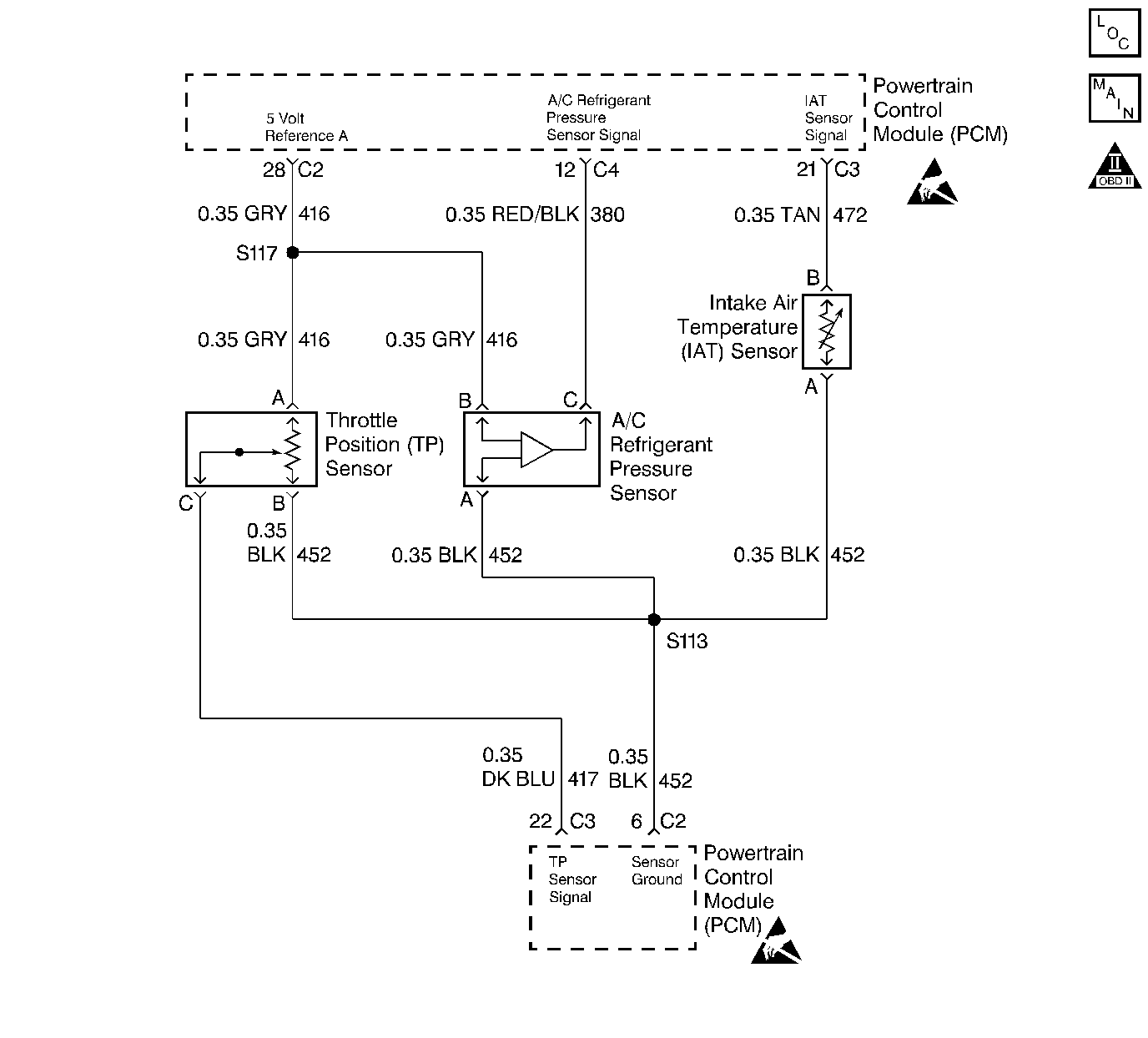
Circuit Description
The Intake Air Temperature (IAT) sensor contains a semiconductor device which changes resistance based on temperature (a thermistor). The IAT sensor is located in the air intake passage of the engine air induction system. The IAT sensor has a signal circuit and a ground circuit. The PCM applies a voltage (about 5.0 volts) on the signal circuit to the sensor. The PCM monitors changes in this voltage caused by changes in the resistance of the sensor to determine intake air temperature.
When the intake air is cold, the sensor (thermistor) resistance is high, and the PCMs signal voltage is only pulled down a small amount through the sensor to ground. Therefore, the PCM will sense a high signal voltage (low temperature). When the intake air is warm, the sensor resistance is low, and the signal voltage is pulled down a greater amount. This causes the PCM to sense a low signal voltage (high temperature).
When the PCM senses a signal voltage lower than the normal operating range of the sensor, this DTC will set.
Conditions for Setting the DTC
| • | DTCs P0100, P0102, P0103, P0117, P0118, P0502, P0503 not set. |
| • | Engine operating longer than 30 seconds. |
| • | Vehicle speed greater than 40 km/h (25 mph). |
| • | Intake Air Temperature greater than 150°C (302°F). |
| • | All conditions met for 4.5 seconds. |
Action Taken When the DTC Sets
| • | The PCM will illuminate the Malfunction Indicator Lamp (MIL) on the second consecutive drive trip that the diagnostic runs and fails. |
| • | The PCM will record operating conditions at the time the diagnostic fails. The first time the diagnostic fails, this information will be stored in Failure Records. If the diagnostic reports a failure on the second consecutive drive trip, the operating conditions at the time of failure will be written to Freeze Frame and the Failure record will be updated. |
Conditions for Clearing the MIL/DTC
| • | The PCM will turn the MIL OFF after three consecutive drive trips that the diagnostic runs and does not fail. |
| • | A last test failed (Current DTC) will clear when the diagnostic runs and does not fail. |
| • | A History DTC will clear after forty consecutive warm-up cycles, if no failures are reported by this or any other emission related diagnostic. |
| • | PCM battery voltage is interrupted. |
| • | Using a Scan tool. |
Diagnostic Aids
| • | An intermittent may be caused by the following: |
| - | Mis-routed harness |
| - | Rubbed through wire insulation |
| - | Broken wire inside the insulation. |
| • | If other DTCs are set that share the same ground and/or 5.0 volt reference circuit, check for faulty connections and for faulty wiring. |
| • | If the engine has been allowed to sit overnight, the engine coolant temperature and engine intake air temperature values should display within a few degrees of each other. If the temperatures are not within 3°C (5°F), refer to Temperature vs Resistance . |
| • | If it is determined that the DTC occurs intermittently, performing the P1112 diagnostic table may isolate the cause of the fault. |
For intermittents, refer to Symptoms .
Test Description
Number(s) below refer to step numbers on the diagnostic table.
-
Determines if the malfunction is present.
-
Using Freeze Frame and/or Failure Records data may aid in locating an intermittent condition. If the DTC cannot be duplicated, the information included in the Freeze Frame and/or Failure Records data can be useful in determining how many miles since the DTC set. The Fail Counter and Pass Counter can also be used to determine how many ignition cycles the diagnostic reported a pass and/or a fail. Operate vehicle within the same freeze frame conditions (RPM, load, vehicle speed, temperature etc.) that were noted. This will isolate when the DTC failed.
-
If the intake air temperature goes below -30°C (-22°F), indicates the PCM and IAT wiring are OK.
-
Disconnecting the PCM will allow using the DVM (J 39200) to check continuity of the circuits. This will aid in locating an open or shorted circuit.
Step
| Action | Value(s) | Yes | No |
|---|---|---|---|---|
1 | Was the Powertrain On-Board Diagnostic (OBD) System Check performed? | -- | ||
Is the IAT above the specified value? | 150°C (302°F) | |||
Does the scan tool indicate that this diagnostic failed this ignition? | -- | Go to Diagnostic Aids | ||
Is the IAT at the specified value? | -40°C (-22°F) | |||
Was the IAT signal circuit grounded? | -- | |||
6 | Replace the IAT sensor. Refer to Intake Air Temperature Sensor Replacement . Is the action complete? | -- | -- | |
7 |
Important:: Replacement PCM must be programmed. Refer to Powertrain Control Module Replacement/Programming . Replace the PCM. Is the action complete? | -- | -- | |
8 |
Does the scan tool indicate that this test ran and passed? | -- | ||
9 | Using the scan tool, select Capture Info, Review Info. Are any DTCs displayed that have not been diagnosed? | -- | Go to the applicable DTC table | System OK |
